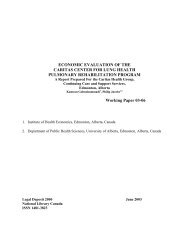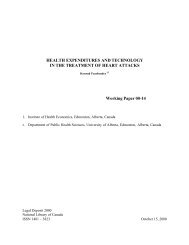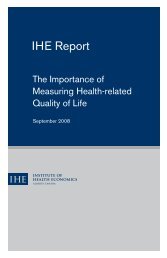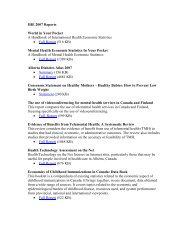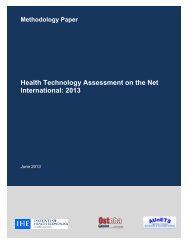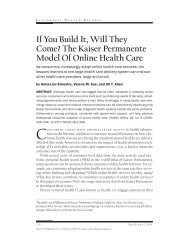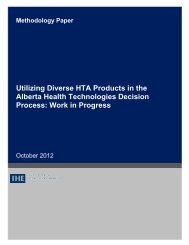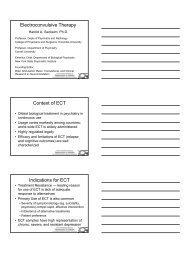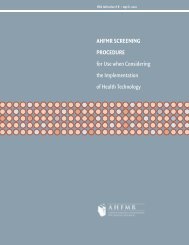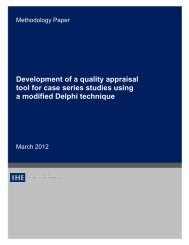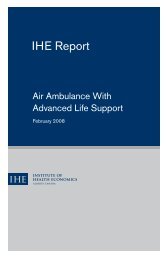Bariatric treatments for adult obesity - Institute of Health Economics
Bariatric treatments for adult obesity - Institute of Health Economics
Bariatric treatments for adult obesity - Institute of Health Economics
- No tags were found...
Create successful ePaper yourself
Turn your PDF publications into a flip-book with our unique Google optimized e-Paper software.
Objectivestudy perspective: societyTo compare the cost-effectiveness <strong>of</strong> the diet counselling strategies <strong>for</strong> patients withsevere <strong>obesity</strong>.Population Patients with a BMI ≥ 43 kg/m 2 .InterventionTime Horizon/discount rateCurrency/priceyearResult<strong>Health</strong> outcomesCostsMarginal analysisConclusionLow-carbohydrate diets were compared with standard diets. Patients in both groupsreceived weekly counselling sessions during the first month and monthly sessions duringthe next 5 months. Patients in the intervention group were counselled to consume lessthan 30 grams <strong>of</strong> carbohydrate per day, while those in control group were counselled t<strong>of</strong>ollow the National Cholesterol Education Program Step 1 diet.1 yearUS$/2001Low-carbohydrate diets generated an additional QALY <strong>of</strong> 0.04, as compared to standarddiets.The total cost associated with low-carbohydrate diets was less than that with standarddiets, with a difference <strong>of</strong> $49.Low-carbohydrate diets were a dominant option due to higher QALYs gained at lowercosts. However, the bootstrap analysis indicated that the difference in costs and QALYswas not statistically significant.The low-carbohydrate diet was not more cost-effective <strong>for</strong> weight loss than was thestandard diet.15 Study 30 Authors/publish year: Sevick/2009; country: US; study type: CEA; setting: primary care;study perspective: payerObjectivePopulationInterventionTime Horizon/discount rateCurrency/ priceyearResult<strong>Health</strong> outcomesCostsMarginal analysisTo assess the cost-effectiveness <strong>of</strong> exercise and diet <strong>for</strong> the treatment <strong>of</strong> <strong>obesity</strong>.Elderly patients aged ≥ 60 years with a BMI ≥ 28 kg/m 2 and knee osteoarthritis.The interventions <strong>of</strong> diet, exercise, and combined exercise and diet were compared withhealthy lifestyle control. Participants in the lifestyle control group were scheduled amonthly meeting <strong>for</strong> one hour during the first three months, including presentations andphysician talks on topics pertaining to osteoarthritis, one session on exercise, and onesession on dietary weight loss. Thereafter, monthly or bimonthly phone contact wasmade.18 months/5%US$/2000The percentage <strong>of</strong> baseline body weight lost was 1.2%, 4.9%, 3.7%, and 5.7% <strong>for</strong> lifestylecontrol, diet, exercise, and combined diet and exercise, respectively.The cost-per-patient per month was $32, $160, $152, and $304 <strong>for</strong> lifestyle control, diet,exercise, and combined diet and exercise, respectively.Compared to lifestyle control, the cost per percentage <strong>of</strong> baseline body weight lost was$35, $48, and $60 <strong>for</strong> diet, exercise, and combined diet and exercise, respectively.<strong>Bariatric</strong> <strong>treatments</strong> <strong>for</strong> <strong>adult</strong> <strong>obesity</strong> 194



